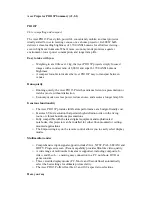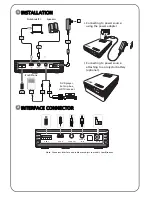
Positive Displacement Vacuum Pumps
Vacuum pumps fall into the same categories as air
compressors do. Tthey are either positive displacement or
non-positive displacement machines. A positive
displacement pump draws a relatively constant volume of air
despite variations in the vacuum levels. The principle types
of positive displacement vacuum pumps are the piston,
diaphragm, rocking piston, rotary vane, lobed rotor, and rotary
screw designs.
Reciprocating Piston Pumps
-The primary advantage of the
piston design is that it can generate relatively high vacuums
from 27 to 28.5"Hg and do so continuously under all kinds of
operating conditions. The major disadvantages are
somewhat limited capacities and high noise levels,
accompanied by vibrations that may be transmitted to the
base structure. In general, the reciprocating piston design is
best suited to pulling relatively small volumes of air through a
high vacuum range.
Diaphragm Pumps
-The diaphragm unit creates vacuum by
flexing of a diaphragm inside a closed chamber. Small
diaphragm pumps are built in both one- and two-stage
versions. The single stage design provides vacuums up to
24"Hg, while the two stage unit is rated for 29"Hg.
Rocking Piston Pumps
-This design combines the light
weight and compact size of the diaphragm unit with the
vacuum capabilities of reciprocating piston units. Vacuums to
27.5"Hg are available with a single stage; two-stage units can
provide vacuums to 29"Hg.
12
1
Positive Displacement Vacuum Pumps
Vacuum pumps fall into the same categories as air
compressors do. Tthey are either positive displacement or
non-positive displacement machines. A positive
displacement pump draws a relatively constant volume of air
despite variations in the vacuum levels. The principle types
of positive displacement vacuum pumps are the piston,
diaphragm, rocking piston, rotary vane, lobed rotor, and rotary
screw designs.
Reciprocating Piston Pumps
-The primary advantage of the
piston design is that it can generate relatively high vacuums
from 27 to 28.5"Hg and do so continuously under all kinds of
operating conditions. The major disadvantages are
somewhat limited capacities and high noise levels,
accompanied by vibrations that may be transmitted to the
base structure. In general, the reciprocating piston design is
best suited to pulling relatively small volumes of air through a
high vacuum range.
Diaphragm Pumps
-The diaphragm unit creates vacuum by
flexing of a diaphragm inside a closed chamber. Small
diaphragm pumps are built in both one- and two-stage
versions. The single stage design provides vacuums up to
24"Hg, while the two stage unit is rated for 29"Hg.
Rocking Piston Pumps
-This design combines the light
weight and compact size of the diaphragm unit with the
vacuum capabilities of reciprocating piston units. Vacuums to
27.5"Hg are available with a single stage; two-stage units can
provide vacuums to 29"Hg.
12
1
Positive Displacement Vacuum Pumps
Vacuum pumps fall into the same categories as air
compressors do. Tthey are either positive displacement or
non-positive displacement machines. A positive
displacement pump draws a relatively constant volume of air
despite variations in the vacuum levels. The principle types
of positive displacement vacuum pumps are the piston,
diaphragm, rocking piston, rotary vane, lobed rotor, and rotary
screw designs.
Reciprocating Piston Pumps
-The primary advantage of the
piston design is that it can generate relatively high vacuums
from 27 to 28.5"Hg and do so continuously under all kinds of
operating conditions. The major disadvantages are
somewhat limited capacities and high noise levels,
accompanied by vibrations that may be transmitted to the
base structure. In general, the reciprocating piston design is
best suited to pulling relatively small volumes of air through a
high vacuum range.
Diaphragm Pumps
-The diaphragm unit creates vacuum by
flexing of a diaphragm inside a closed chamber. Small
diaphragm pumps are built in both one- and two-stage
versions. The single stage design provides vacuums up to
24"Hg, while the two stage unit is rated for 29"Hg.
Rocking Piston Pumps
-This design combines the light
weight and compact size of the diaphragm unit with the
vacuum capabilities of reciprocating piston units. Vacuums to
27.5"Hg are available with a single stage; two-stage units can
provide vacuums to 29"Hg.
12
1
Positive Displacement Vacuum Pumps
Vacuum pumps fall into the same categories as air
compressors do. Tthey are either positive displacement or
non-positive displacement machines. A positive
displacement pump draws a relatively constant volume of air
despite variations in the vacuum levels. The principle types
of positive displacement vacuum pumps are the piston,
diaphragm, rocking piston, rotary vane, lobed rotor, and rotary
screw designs.
Reciprocating Piston Pumps
-The primary advantage of the
piston design is that it can generate relatively high vacuums
from 27 to 28.5"Hg and do so continuously under all kinds of
operating conditions. The major disadvantages are
somewhat limited capacities and high noise levels,
accompanied by vibrations that may be transmitted to the
base structure. In general, the reciprocating piston design is
best suited to pulling relatively small volumes of air through a
high vacuum range.
Diaphragm Pumps
-The diaphragm unit creates vacuum by
flexing of a diaphragm inside a closed chamber. Small
diaphragm pumps are built in both one- and two-stage
versions. The single stage design provides vacuums up to
24"Hg, while the two stage unit is rated for 29"Hg.
Rocking Piston Pumps
-This design combines the light
weight and compact size of the diaphragm unit with the
vacuum capabilities of reciprocating piston units. Vacuums to
27.5"Hg are available with a single stage; two-stage units can
provide vacuums to 29"Hg.
12
1
















































